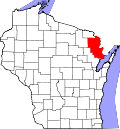History
The first European-American settlers did not come to Menekaunee until 1845, although French-Canadian and American fur traders operated a post near here since the early 19th century. [5]
Unlike Marinette, which went comparatively unscathed the Peshtigo Fire of 1871 (although some buildings were burnt on its western border), Menekaunee was severely damaged by it. About fifty buildings burned down, including an extensive new sawmill, three stores, a flour mill, two hotels, and thirty-five houses. Several scows, nearly a million board feet of lumber, and a number of horses, cows and other animal, were burned. Clouds of burning cinders were driven across the river, and were showered upon the decks of vessels seven miles distant on Green Bay. [6]
This page is based on this
Wikipedia article Text is available under the
CC BY-SA 4.0 license; additional terms may apply.
Images, videos and audio are available under their respective licenses.





